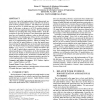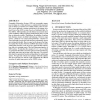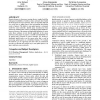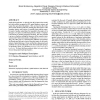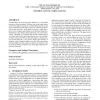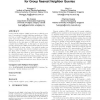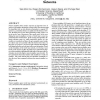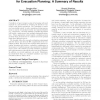194
Voted
GIS
2005
ACM
16 years 1 months ago
2005
ACM
Databases of moving objects are important for air traffic control, ground traffic, and battlefield configurations. We introduce the (historical and spatial) range close-pair query...
212
Voted
GIS
2005
ACM
16 years 1 months ago
2005
ACM
The R*-tree, as a state-of-the-art spatial index, has already found its way into commercial systems like Oracle. In this paper, we aim at improving query performance of the R*tree...
217
Voted
GIS
2005
ACM
16 years 1 months ago
2005
ACM
A necessary step in the implementation of three-dimensional spatial data types for spatial database systems and GIS is the development of robust geometric primitives. The authors ...
222
click to vote
GIS
2005
ACM
16 years 1 months ago
2005
ACM
Geographic Information Systems (GIS) are increasingly managing very large sets of data and hence a centralized data repository may not always provide the most scalable solution. H...
238
Voted
GIS
2005
ACM
16 years 1 months ago
2005
ACM
Recent advances in low-power sensing devices coupled with the widespread availability of wireless ad-hoc networks have fueled the development of sensor networks. These are typical...
199
Voted
GIS
2005
ACM
16 years 1 months ago
2005
ACM
Topological predicates, as derived from the 9-intersection model, have been widely recognized in GIS, spatial database systems, and many other geo-related disciplines. They are ba...
215
click to vote
GIS
2005
ACM
16 years 1 months ago
2005
ACM
An interesting issue in moving objects databases is to find similar trajectories of moving objects. Previous work on this topic focuses on movement patterns (trajectories with tim...
206
Voted
GIS
2005
ACM
16 years 1 months ago
2005
ACM
Group nearest neighbor (GNN) queries are a relatively new type of operations in spatial database applications. Different from a traditional kNN query which specifies a single quer...
207
Voted
GIS
2005
ACM
16 years 1 months ago
2005
ACM
Nearest neighbor (NN) searches represent an important class of queries in geographic information systems (GIS). Most nearest neighbor algorithms rely on static distance informatio...
214
Voted
GIS
2005
ACM
16 years 1 months ago
2005
ACM
Contraflow, or lane reversal, is a way of increasing outbound capacity of a real network by reversing the direction of inbound roads during evacuations. The contraflow is consider...

